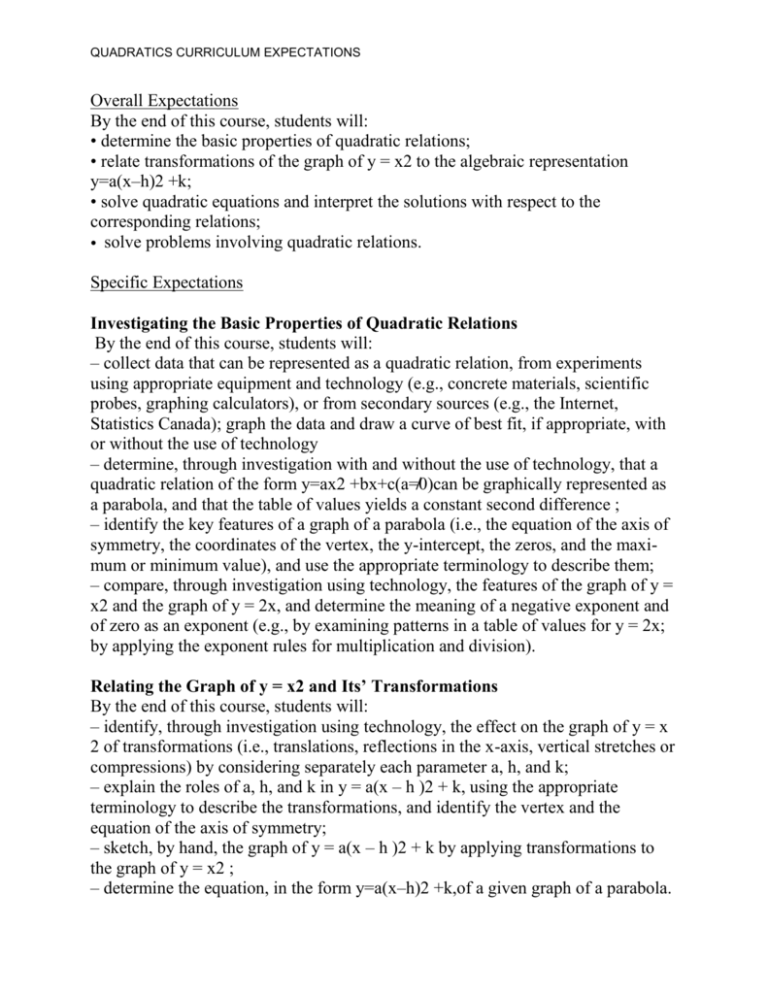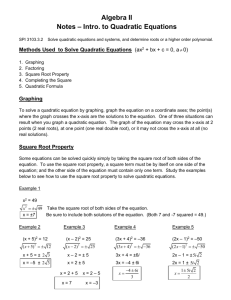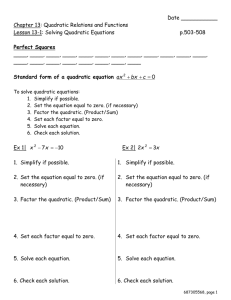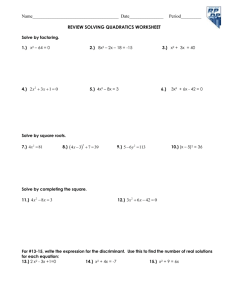10D CURRICULUM QUADRATICS
advertisement

QUADRATICS CURRICULUM EXPECTATIONS Overall Expectations By the end of this course, students will: • determine the basic properties of quadratic relations; • relate transformations of the graph of y = x2 to the algebraic representation y=a(x–h)2 +k; • solve quadratic equations and interpret the solutions with respect to the corresponding relations; • solve problems involving quadratic relations. Specific Expectations Investigating the Basic Properties of Quadratic Relations By the end of this course, students will: – collect data that can be represented as a quadratic relation, from experiments using appropriate equipment and technology (e.g., concrete materials, scientific probes, graphing calculators), or from secondary sources (e.g., the Internet, Statistics Canada); graph the data and draw a curve of best fit, if appropriate, with or without the use of technology – determine, through investigation with and without the use of technology, that a quadratic relation of the form y=ax2 +bx+c(a≠0)can be graphically represented as a parabola, and that the table of values yields a constant second difference ; – identify the key features of a graph of a parabola (i.e., the equation of the axis of symmetry, the coordinates of the vertex, the y-intercept, the zeros, and the maximum or minimum value), and use the appropriate terminology to describe them; – compare, through investigation using technology, the features of the graph of y = x2 and the graph of y = 2x, and determine the meaning of a negative exponent and of zero as an exponent (e.g., by examining patterns in a table of values for y = 2x; by applying the exponent rules for multiplication and division). Relating the Graph of y = x2 and Its’ Transformations By the end of this course, students will: – identify, through investigation using technology, the effect on the graph of y = x 2 of transformations (i.e., translations, reflections in the x-axis, vertical stretches or compressions) by considering separately each parameter a, h, and k; – explain the roles of a, h, and k in y = a(x – h )2 + k, using the appropriate terminology to describe the transformations, and identify the vertex and the equation of the axis of symmetry; – sketch, by hand, the graph of y = a(x – h )2 + k by applying transformations to the graph of y = x2 ; – determine the equation, in the form y=a(x–h)2 +k,of a given graph of a parabola. QUADRATICS CURRICULUM EXPECTATIONS Solving Quadratic Equations By the end of this course, students will: – expand and simplify second-degree polynomial expressions, using a variety of tools and strategies; – factor polynomial expressions involving common factors, trinomials, and differences of squares, using a variety of tools and strategies; – determine, through investigation, and describe the connection between the factors of a quadratic expression and the x-intercepts (i.e., the zeros) of the graph of the corresponding quadratic relation, expressed in the form y = a(x – r)(x – s); – interpret real and non-real roots of quadratic equations, through investigation using graphing technology, and relate the roots to the x-intercepts of the corresponding relations; – express y=ax2 +bx+c in the form y=a(x–h)2 +k by completing the square in situations involving no fractions, using a variety of tools; – sketch or graph a quadratic relation whose equation is given in the form y=ax2 +bx+c, using a variety of methods (e.g., sketching y = x2 – 2x – 8 using intercepts and symmetry; sketching y=3x2 –12x+1 by completing the square and applying transformations; graphing h = –4.9t2 + 50t + 1.5 using technology); – explore the algebraic development of the quadratic formula (e.g., given the algebraic development, connect the steps to a numerical example; follow a demonstration of the algebraic development [student reproduction of the development of the general case is not required]); – solve quadratic equations that have real roots, using a variety of methods (i.e., factoring, using the quadratic formula, graphing). Solving Problems Involving Quadratic Relations By the end of this course, students will: – determine the zeros and the maximum or minimum value of a quadratic relation from its graph (i.e., using graphing calculators or graphing software) or from its defining equation (i.e., by applying algebraic techniques); – solve problems arising from a realistic situation represented by a graph or an equation of a quadratic relation, with and without the use of technology.









